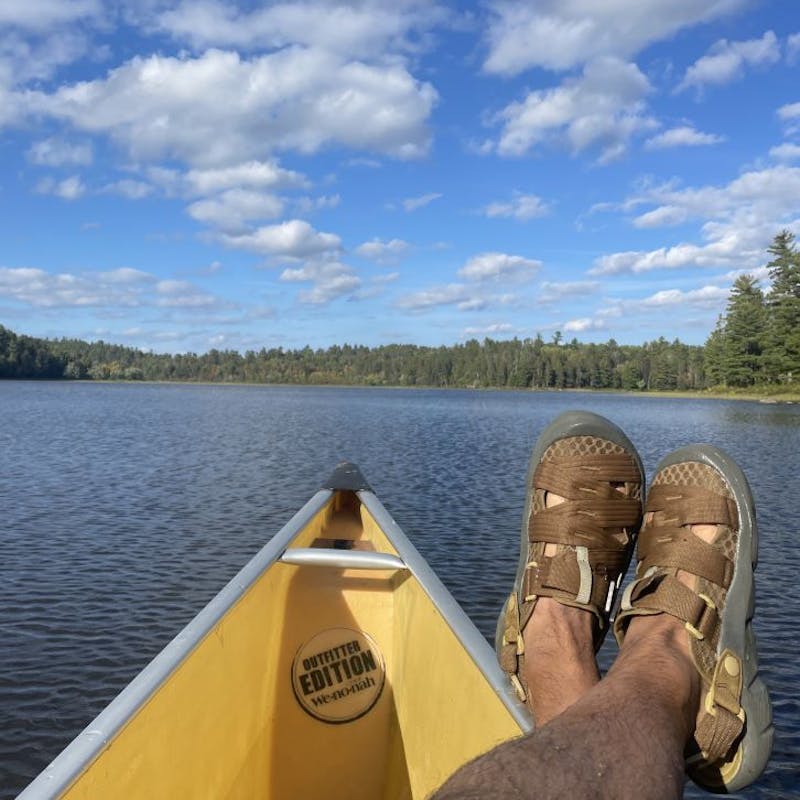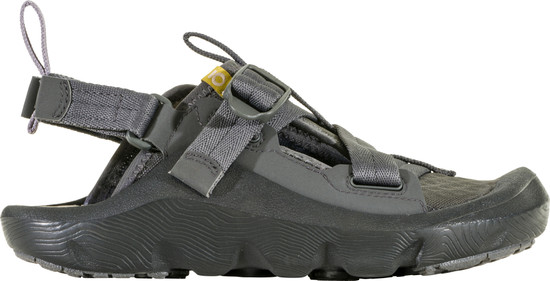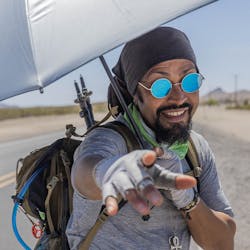During my preparation for my upcoming adventure in the Boundary Waters Canoe Area Wilderness (BWCAW), I pondered the fact that this would mark my first ever canoe outing.
Rob Coughlin, the proprietor of Granite Gear, extended an invitation to join him and a group of thru-hikers for a three-day paddling escapade in the immaculate wilderness.
The BWCAW is a gem hidden away in the northern reaches of Minnesota, known for its rugged beauty and pristine lakes. It's a place where the sounds of the city are replaced by the soothing whispers of the wind through the pines and the gentle lapping of the water against the canoes. As an author and lover of the great outdoors, I couldn't have asked for a better setting for my introductory canoeing adventure.
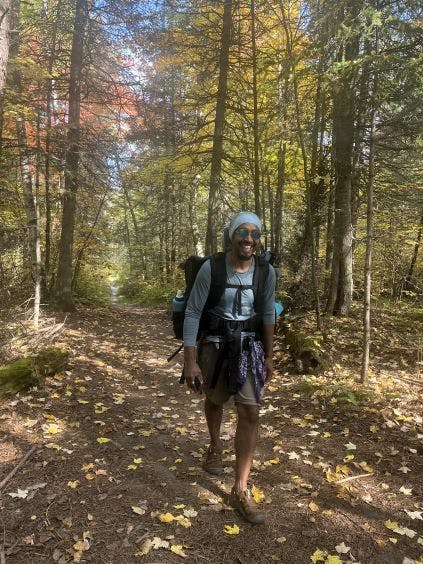
We start our canoe journey at Ely, a once iron ore mine town in Minnesota, now an entry point for campers and canoers into the BWCAW and Canada's Quetico Provincial Park wilderness area. It’s 7am, and we make our way to Piragis Outfitting, where we rendezvous with our guide for this extraordinary journey, the seasoned Tim Barton. After he secures the canoes atop the two vehicles, our group of six piles in, and our adventure begins.
The journey from Ely to our entry point takes around 1.5 hours, yet the vibrant fall foliage captivated my attention, making the ride feel shorter. Upon reaching our entry point, we commence unloading our gear. Tim then informs us that we'll begin with a half-mile portage.
"Portage?" I inquired.
The term was unfamiliar to me. As it turns out, portage involves carrying our gear and canoe across a stretch of land between two bodies of water.
Tim, our exceptionally experienced guide, doesn't hesitate. With a portage pack on his back, he effortlessly flips a canoe over his head and skillfully rests it on his shoulders, displaying remarkable ease and agility. I'm impressed by his ability to handle both his portage pack and a two-person canoe simultaneously, each weighing approximately 60 pounds.
I volunteered to carry just the canoe; I'd return for the portage pack. The canoe itself didn't feel heavy, but maintaining its balance on my shoulders was tricky. It seemed to have a mind of its own, almost eager to brush against trees and hit the large rocks on the trail, especially while descending hills.
“Try tipping the front downward when going downhill to prevent the back from touching the ground,” Tim suggests, while skillfully twirling his carried canoe like a basketball on his finger.
Admittedly, he wasn't performing such theatrics, but compared to my comical struggles, it felt that way. Honestly, attempting his technique might result in the canoe’s weight propelling me forward, landing face-first with the canoe covering my body, resembling the house on top of the Wicked Witch of the East.
“Ok, I’ll try. Thanks, Tim,” I respond.
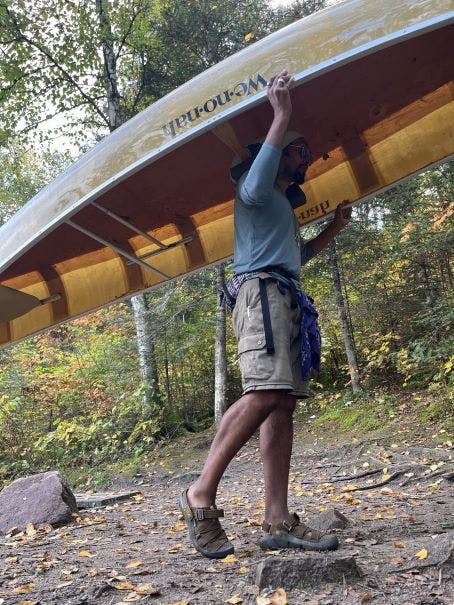
I stagger my way to our launching point, feeling like I’ve hit my limit after just half a mile. Any longer, and I’d have to declare a mandatory siesta. Tim graciously relieves me of the canoe.
“Phew, piece of cake,” I chuckle, trying to cover my struggle.
All geared up and loaded into the canoes, we're set to start paddling. Being a novice in canoeing, I was positioned at the bow, while Donna aka Nature, another thru-hiker but with canoeing experience, took the stern to navigate the start of our journey through Nina Moose Lake toward a designated camp on Lake Agnes.
My first paddle strokes introduced a rush of exhilaration mixed with a tinge of uncertainty while maneuvering the canoe over beaver dams. Each push on the open path of water through wild rice, unveiled a blend of thrill and learning, creating a captivating tapestry of excitement, discovery and…
“Let's be careful not to shift too much in the canoe; we wouldn’t want to tip over,” I mumble to myself, the solitary voice in this conversation.
Alright, it might have taken me a moment to get used to the canoe’s movements. After paddling for an hour, I’ve become as at ease as a consummate sailor.
Whoa, I nearly dropped my paddle in the water.
Maybe not as skillful as a sailor.
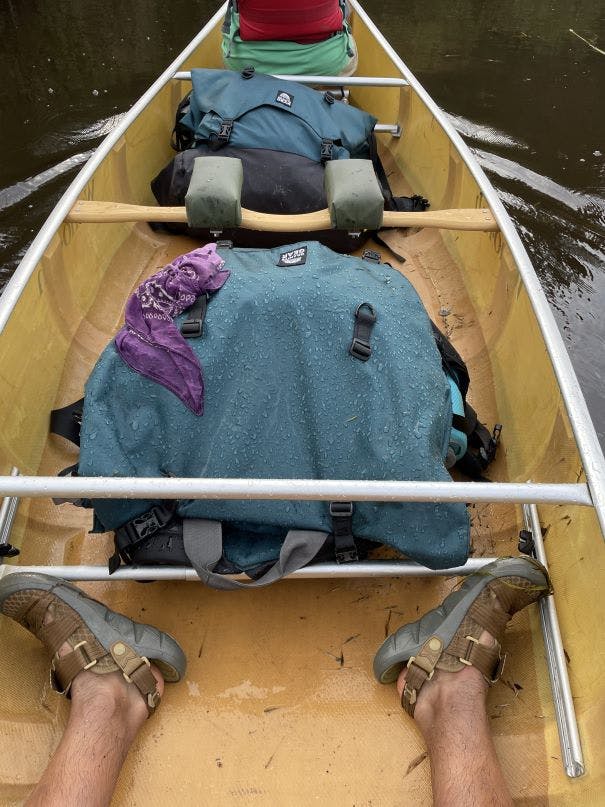
Three hours later we’re closing in on our first campsite. However, our progress halts when a father with two kids paddling past us shares alarming news of a bear attempting to reach their hung food bag, causing them distress all night long.
“Change of plans. We're skipping our initial campsite and heading farther to Lac La Croix,”
Tim declares. We collectively concur that it's the wise decision. While I was prepared to cease the already long day of paddling, the idea of encountering a hungry bear was not on my agenda. Even though Tim doesn't vocalize it, I sense our alternate destination is quite a distance away. However, Rob contends that, in his view, it's the most beautiful area of the Boundary Waters. That's a compelling enough reason for me to endure a bit longer.
Two more hours later, we make it to a campsite on an island close to Warrior Hill, a prominent granite rock formation, situated on Lac La Croix Lake. It's a stunning campsite boasting a neatly assembled rock fire pit equipped with a steel grill grate for cooking, ample tent space, and a newly crafted commode.
We begin pitching our tents as Tim switches into full chief mode. I was impressed by his preparation of a vegan dish for me. Tim and Rob were clearly good friends, and their camaraderie added an extra layer of warmth to the journey. Tim's great knowledge of canoeing in the Boundary Waters and Rob’s humor made each day more entertaining and memorable.
While storytelling around the campfire, we eagerly anticipated the possibility of witnessing the Aurora Borealis. As the day faded, the sunset painted the sky in a breathtaking symphony of colors, with fiery reds, warm oranges, and soft purples reflecting off the calm, glassy waters. The fading light casts a tranquil hush over the wilderness, as the last rays bid farewell to the day, creating a relaxed vibe that made way for another magical moment. One I’ve been scanning the dark sky for the instant I saw the first bright star in the darkened sky.
Slowly but surely, a breathtaking display of the northern lights started to form over the lake, just beyond the Canadian side of the wilderness. The sky came alive with vibrant colors, as the aurora danced across the heavens. This mesmerizing natural phenomenon decorated the night sky with hues of emerald green, Prince purple, and hints of vibrant red, creating an otherworldly spectacle. Lights arched above us, as if painting the sky inside a dome. It felt as though I was encapsulated within a celestial snow globe. It was a sight that left us all in awe, our spirits lifted by the enchanting and ethereal beauty of this remote paradise. How timely for us that it was the last night of the month to witness the light show. I was grateful and felt a bit special to be part of this universal design.
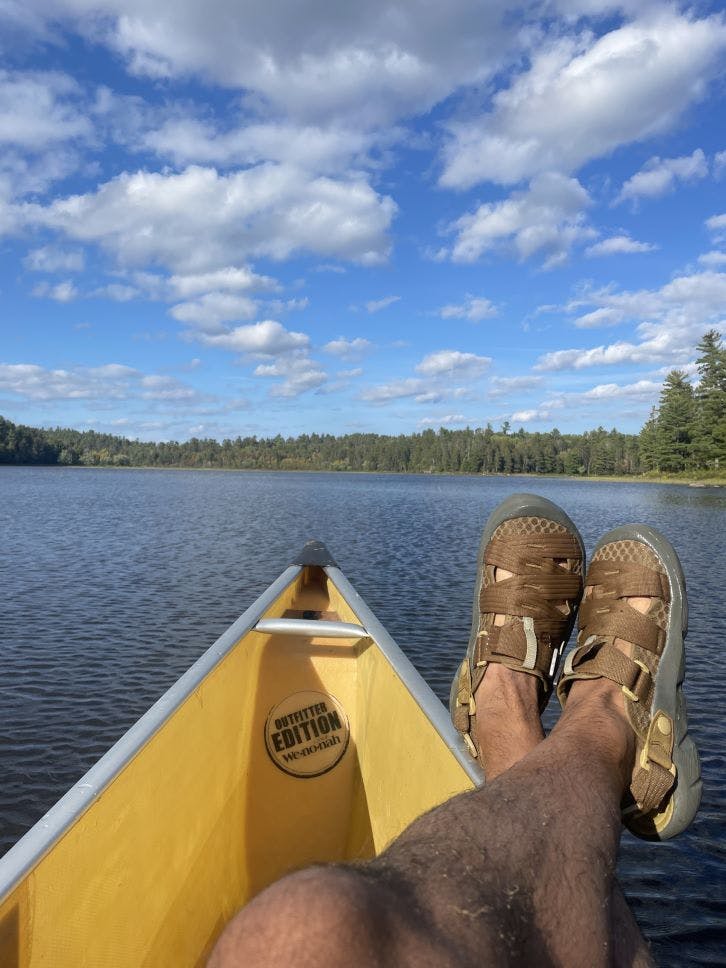
The next morning, we paddled our canoes to the Lac La Croix Pictographs, ancient rock paintings depicting stories of the Ojibwa people and the history of this remarkable place. Among the pictographs, we were fascinated to see one that resembled a moose. The pictographs are connection to the past that added a layer of mystery to our journey. It was a reminder that we were just visitors in this timeless wilderness, with a responsibility to protect its wonders.
Afterwards we paddled to a new campsite on Nina Moose Lake. The change of location added a fresh perspective to our journey, as we set up camp once more. Fishing was Rob’s only focus, and on our last evening, he caught a fish that everyone else savored, except for the vegan among us. I was content not having fish; the mirror-like lake reflecting the towering pines had me captivated, crafting a surreal, almost dreamlike ambiance.
Seated on the camp chair, I pondered our surroundings and the purpose behind our presence. Our journey wasn’t merely for the thrill; it was also a commitment to support the Save the Boundary Waters initiative.
The day before our paddling adventure, Rob led us to the Save the Boundary Waters headquarters, where we were introduced to Lacey, the manager of Boundary Waters Connect. Lacey shared with us the looming threat that the most visited wilderness is facing.
She told us that the Save the Boundary Waters cause aims to protect this precious wilderness from potential threats like sulfide-ore copper mining, which could harm the fragile ecosystem and the sheer untouched beauty that drew us all here. It's a coalition of environmentalists, outdoor enthusiasts, local communities, and various organizations dedicated to safeguarding this natural paradise from industrial exploitation, aiming to protect its unspoiled beauty, diverse wildlife, and the recreational opportunities it offers for future generations.
The dedicated team at Save the Boundary Waters poured their efforts into securing a 20-year ban on sulfide-ore copper mining activities. However, this temporary solution is akin to a bandage that won't hold for the long term. The ongoing battle to protect this precious wilderness remains far from its conclusion.
As we left the headquarters, Lacey’s words rung in my head, like a punch in the ear from a boxer. I instantly felt it was my duty to be a part of this initiative and help raise awareness about the importance of preserving this natural wonder.
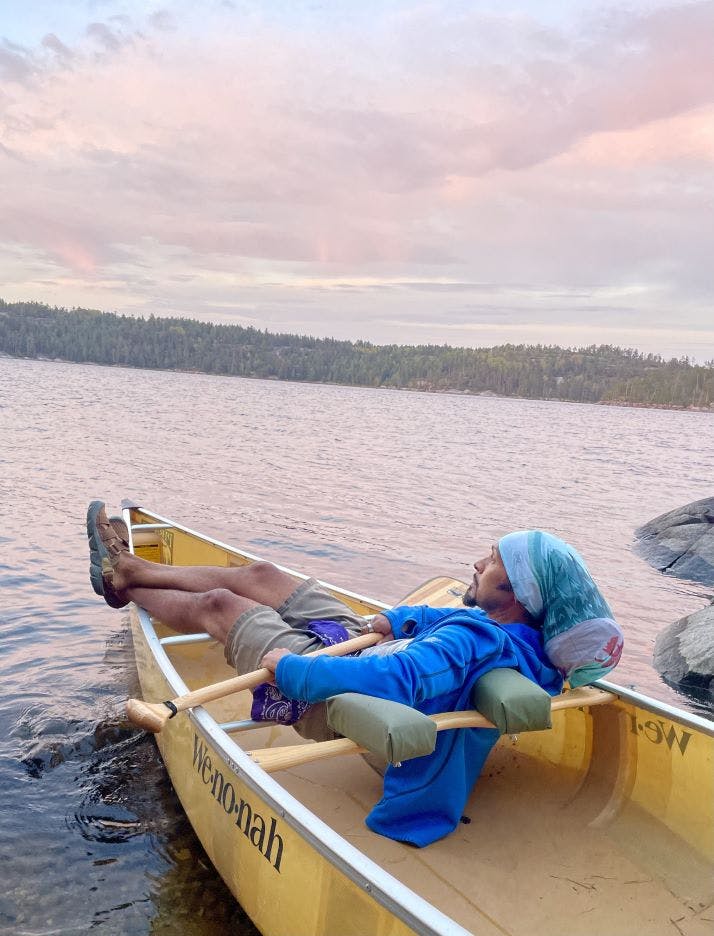
The following morning, our final hours in this marvelous wilderness, I made a conscious effort to absorb every aspect of this enchanting place. We paddled past rocky outcroppings, watched eagles soar overhead, and even viewed a bevy of swan on the lake at a distance. A loon swam close to our canoe before diving into the lake and disappearing into the dark water.
While paddling, with the sun kissing my face and the gentle symphony of paddle meeting water, I was reminded of the significance of preserving such sanctuaries. My connection with the Save the Boundary Waters initiative grew stronger with each passing day. As an author, I couldn't help but weave the beauty of this place into my writing, emphasizing the urgent need to protect it. The serenity and magic of this place were something that words alone couldn't capture, but I was determined to try.
Despite the portages—each becoming notably easier, particularly with my choice of Obōz Whakatā Trail hiking sandals, the ideal canoe shoe— the altered plans, and the occasional sideways spin of the canoe (finding myself at the stern, steering while Nature led at the bow), our journey remained undeniably inspiring. We discovered not only the beauty of the wilderness but also the strength within ourselves. There’s something about being out in nature, away from the distractions of the modern world, that makes you reflect on your own journey. I found new inspiration in the quiet solitude of the Boundary Waters.

